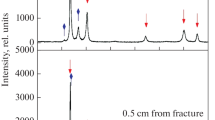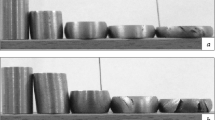Sparingly alloyed high-manganese austenitic steels 40G20 and 25G20S3 are studied. The phase composition, the structure and the mechanical properties of the steels are determined after quenching from the austenitic range, and their variation during tension of standard specimens is studied by the methods of transmission electron microscopy and x-ray diffraction analysis. The characteristics of strain hardening of the steels are determined from the results of the mechanical tests. It is shown that the strain develops either by twinning (TWIP effect, steel 40G20) or due to formation of strain martensite (TRIP effect, steel 25G20S3) depending on the stacking fault energy. The change in the strain mechanism changes the strain hardening and the strength and ductility properties of the steels.





Similar content being viewed by others
References
R. A. Hadfield, “Hadfield’s manganese steel,” Science, 12(306), 284 – 286 (1888).
I. N. Bogachev and V. F. Glagolev, Structure and Properties of Iron-Manganese Alloys [in Russian], Metallurgiya, Moscow (1973), 295 p.
O. Bouaziz, H. Zurob, B. Chehab, et al., “Effect of chemical composition on work hardening of Fe – Mn – C TWIP-steels,” Mater. Sci. Tech., 27(3), 707 – 709 (2011).
X. Liang, J. R. McDermid, O. Bouaziz, et al., “Microstructural evolution and strain hardening of Fe – 24Mn and Fe – 30Mn alloys during tensile deformation,” Acta Mater., 57(13), 3978 – 3988 (2009).
D. T. Pierce, J. A. Jimenez, J. Bentley, et al., “The influence of stacking fault energy on the microstructural and strain hardening evolution of Fe –Mn – Al – Si steels during tensile deformation,” Acta Mater., 100, 178 – 190 (2015).
M. Koyamata, T. Sawagichi, T. Lee, et al., “Work hardening associated with ε-martensitic transformation, deformation twinning and dynamic strain aging in Fe – 17Mn – 0.6C and Fe – 17Mn – 0.8C TWIP steels,” Mater. Sci. Eng. A, 528(24), 7310 – 7316 (2011).
S. Curtze and V.-T. Kuokkala, “Dependence of tensile deformation behavior of TWIP steels on stacking fault energy, temperature and strain rate,” Acta Mater., 58(15), 5129 – 5141 (2010).
B. C. De Cooman, Yu. Estrin, and S. K. Kim, “Twinning induced plasticity (TWIP) steels,” Acta Mater., 142, 283 – 362 (2018).
J. K. Kim and B. C. De Cooman, “Stacking fault energy and deformation mechanisms in Fe – xMn – 0.6C – yAl TWIP steel,” Mater. Sci. Eng. A, 676, 216 – 231 (2016).
D. T. Pierce, J. Bentley, J. A. Jimenez, and J. E. Witting, “Stacking fault energy of measurements of Fe – Mn – Al – Si austenitic twinning induced plasticity steels,” Scr. Mater., 66, 753 – 756 (2012).
R. Honeycomb, Plastic Deformation of Metals [Russian translation], Mir, Moscow (1972), 406 p.
Author information
Authors and Affiliations
Corresponding author
Additional information
Translated from Metallovedenie i Termicheskaya Obrabotka Metallov, No. 3, pp. 3 – 6, March, 2020.
Rights and permissions
About this article
Cite this article
Gervas’ev, M.A., Khotinov, V.A., Ozerets, N.N. et al. Changes in Microstructure and Strain Hardening of High-Manganese Steels Under Tension. Met Sci Heat Treat 62, 183–187 (2020). https://doi.org/10.1007/s11041-020-00534-z
Published:
Issue Date:
DOI: https://doi.org/10.1007/s11041-020-00534-z




